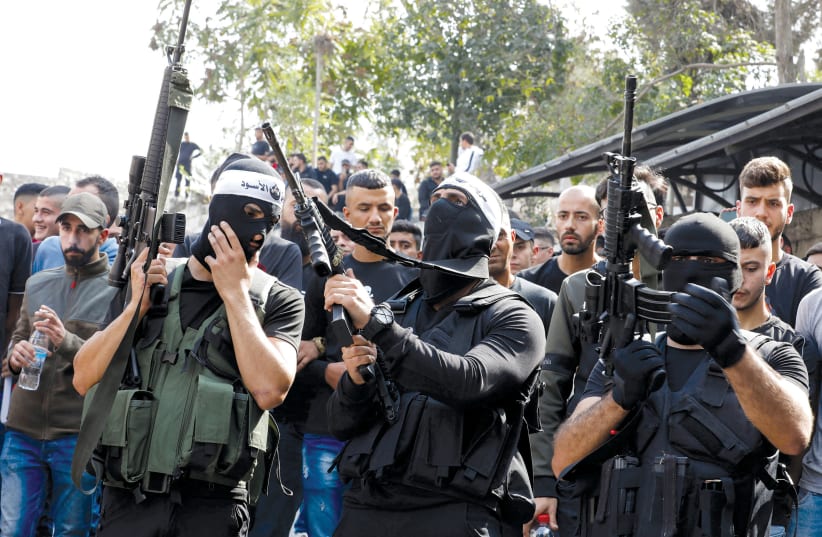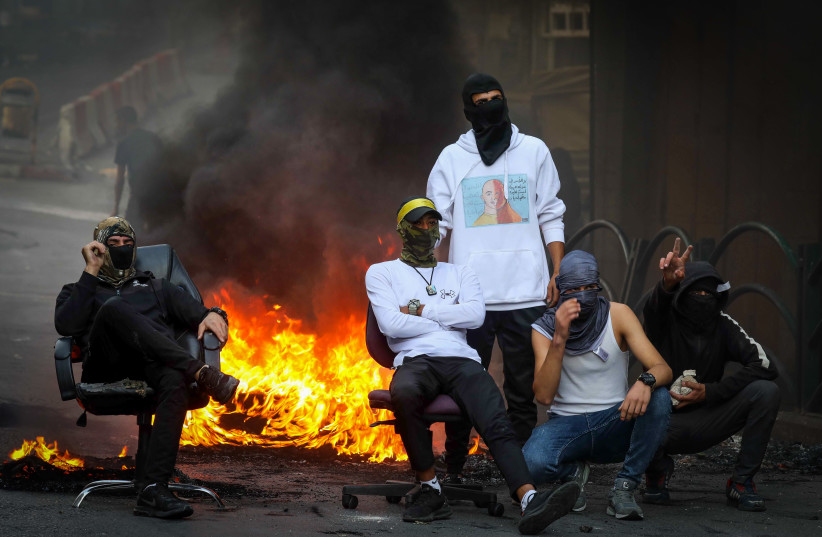In recent months there have been increasing clashes between Israeli security forces and Palestinian armed terror groups. This has included clashes with Palestinian Islamic Jihad and the Lion’s Den group in Nablus. This comes amid an increase in attempts to thwart the smuggling of illegal weapons in the West Bank. Palestinians armed with or found with illegal parts for M-16s are a frequent aspect of the recent clashes.
The Foundation for Defense of Democracies and their research analyst Joe Truzman have spotlighted the rise in violence in the West Bank via a new mapping project. Truzman is a research analyst at FDD's Long War Journal website where he focuses primarily on Palestinian militant groups and Hezbollah.
An introduction to the “mapping terrorism in the West Bank” project notes that “the security situation in the West Bank is volatile. A mosaic of terrorist groups — many backed by the Islamic Republic of Iran — has found the West Bank ripe ground for plotting violence and attacking Israelis. The mapping project covers the period of Israel’s ongoing Operation Break the Wave which is intended to “break” this wave of unrest. It’s unclear how much success this is having, because the nightly raids and clashes appear to continue.
The map is interesting because it shows visually the increase in terrorist incidents this year, peaking in October with 169 recorded ones. December has also seen dozens of incidents so far. The map is interesting because it shows visually how many incidents have taken place in and around Ramallah, Nablus and Jenin. By contrast, the southern West Bank, mostly around Hebron, has seen less of them.
The overall picture is that there is a lot of violence in the West Bank and even though Israel’s security forces are keeping up the pressure, the violence doesn’t appear to be going away any time soon.
The violence in the West Bank isn't going away any time soon
“The Palestinian Authority has slowly lost its influence in pockets of the West Bank, which has allowed militant organizations to thrive in areas such as Jenin and Nablus,” Truzman says. “When the Lions’ Den first emerged back in August, I observed that the group appeared to be well-supported, which was not characteristic of a new Palestinian militant organization. I suspect they are being financially and militarily supported by another actor, but I can’t prove who is behind it.”
The FDD analyst notes that the West Bank is being flooded with weapons that are destabilizing the area. At The Jerusalem Post, we have done research into the origin and prevalence of illegal weapons in the West Bank and documented in recent articles the large number of M-16s in the hands of Palestinians in places like Jenin and Nablus. Truzman’s view correlates with what we have seen.
“These militant organizations are undermining the PA, which isn’t doing enough to stop these organizations. And this is causing the IDF to launch repeated operations in Jenin, Nablus and other northern West Bank cities, which leads to armed clashes,” Truzman says. “As far as trends are concerned, I believe Israel is nearing a tipping point where one mass casualty attack linked to a West Bank organization will spur a broad operation in the West Bank.”
THE PALESTINIAN Authority doesn’t appear interested in curtailing these groups, either because it doesn’t have the resources or because it doesn’t want an armed conflict with its own people. Instead, the PA has done things like focus on arresting dissidents, such as students this week. That leaves Israel to fight an ongoing low-level conflict with groups like Islamic Jihad and Lion’s Den.
“The Lions’ Den and another militant organization have a lot of support from the Palestinian street, and the PA has been reluctant to clamp down on these groups due to their popularity,” Truzman says. “They are outsourcing the arrests to the IDF. And as we see, there are constant firefights almost every time the IDF goes into Jenin and Nablus.”
What is the motive behind the recent uptick in violence and parades of armed young men with rifles? “This is a generation that doesn’t recall the Second Intifada; they grew up in poor living conditions and grew up around so-called ‘martyrs’… as the influence of the PA [diminishes], we see criminal gangs and militants begin to thrive. We now see an outside influence and support of these organizations – specifically the Lion’s Den – and this has created an uptick in violence.”
While much is known about the clashes because they are documented on both sides – and about the weapons in the hands of the terrorists and militants – less is known about where the money and weapons come from. In the show The Wire, there is a scene where the character Lester Freamon says “you follow drugs, you get drug addicts and drug dealers. But you start to follow the money, and you don't know where it's gonna take you.”The same could be said for the West Bank. One can follow the guns and find gun dealers – and find that they were smuggled across after being stolen – or they consist of parts that are smuggled and then assembled later. But what about the money and other types of support? “I don’t have direct evidence but it benefits Hamas to undermine the PA,” Truzman says. “There have been some threats by the IRGC. I think [IRGC leader] Hossein Salami threatened earlier this year they would support militant groups in the West Bank. There is no direct evidence that the IRGC is linked to arming militants.”
MUCH IS changing in the region. In 2018, Iran tried to fly a drone from a T-4 base in Syria to the West Bank to transport explosives to the Palestinians. The drone was shot down. These days, the Syrian regime recently hosted Hamas and Iran is using Syria to transfer weapons to Hezbollah.
Truzman says he is concerned that the uptick in violence could lead to a larger incident. He describes this as a potential “mass casualty” type of event, like a large terror attack that provokes an IDF operation. “They try to launch terror attacks inside Israel,” he says. “There is a correlation between Gaza, the West Bank and attacks being orchestrated against targets inside Israel.”
In addition, there are reports that Hamas has been seeking to direct cells in the West Bank, a repetition of the events that led to the 2014 war between Israel and Hamas after one of its cells murdered three teens in the West Bank.
Meanwhile, in Gaza, Hamas is not remaining stagnant either. It is trying to improve its terror infrastructure after setbacks in the May 2021 war. This includes a focus on underwater threats, such as using dual-use diving propulsion vehicles and other means to threaten Israel.

